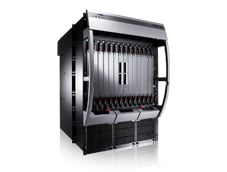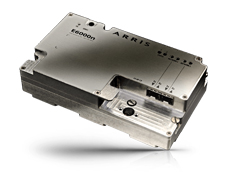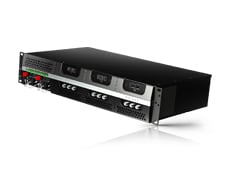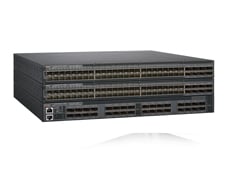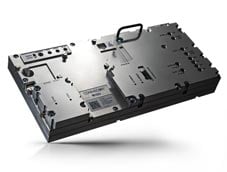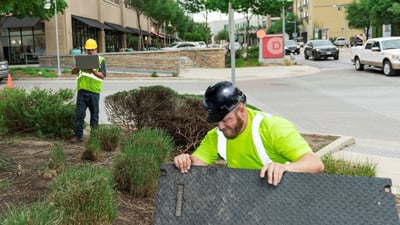Evolution to Distributed Access Architectures (DAA)
Video and data capabilities for distributed network evolution
Bandwidth usage continues to grow year-on-year, a trend driven by consumer video consumption from internet video services. Service providers are looking to extend their service offerings to deliver IP video, 4K video, and business services. Meeting network demand—as well as managing practical constraints in their network operations, including physical space, power consumption and cooling in head-end locations—is driving the evolution of the network.
Distributed access architecture (DAA) enables the evolution of cable networks by decentralizing and virtualizing headend and network functions. DAA extends the digital portion of the headend or hub domain out to the fiber-optic node and places the digital-to-RF interface at the optical-coaxial boundary in the node. Replacing the analog optics from the headend converts the fiber link to a digital fiber Ethernet link, increasing the available bandwidth by improving fiber efficiencies (wavelengths and distance) and directional alignment with the NFV/SDN/FTTx systems of the future.
HFC networks are defined by their analog fiber plumbing. DAA replaces analog fiber with IP connections (digital fiber) and creates a software-defined network that supports:
- Node evolution with remote PHY and remote MAC-PHY
- Transition to digital optics, removing analog lasers
- Digital fiber closer to the subscriber’s home
- Migration to centralized data centers
- Flexible advertising, channel lineups and bandwidth management
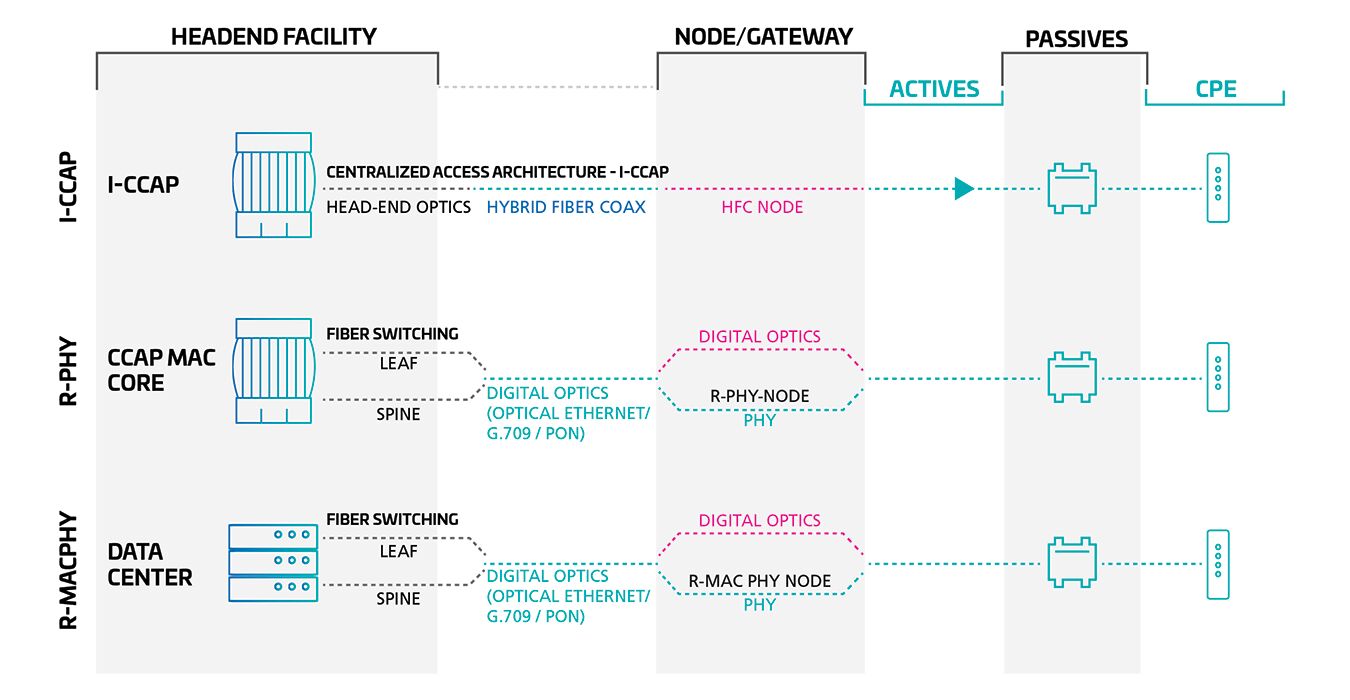
Advantages of a DAA approach
- Network efficiency
- Increased network capacity and simpler outside plant maintenance
- Node evolution with remote PHY, remote MAC-PHY and remote 10G EPON OLT
- Better end-of-line signal quality, higher modulation rates, higher bit rates
- Better spectral efficiency, more wavelengths per fiber
- Operational and capital expenditure benefits
- Reduced head-end power, space and cooling requirements
- Hub consolidation
- Ability to add QAMs without changing the RF combining network
- Digital fiber “set and forget”
- IP convergence
- Extend IP network to the node
- Alignment with FTTx build-out
- Ability to leverage standards-based interconnectivity and economies of scale
For service providers, the resources to run additional fiber, implement node splits, and upgrade head-end facilities require significant investment. DAA can be implemented gradually with normal plant and service upgrades and without disrupting legacy services.
With a long-term commitment to the cable industry, CommScope has over 20 years of experience and ongoing development and support in the delivery of broadband and video services:
- High-speed data
- CMTS
- HFC infrastructure
- Video infrastructure
- CPE (modems, set-tops, gateways)
- FTTx transition
- Back-office support
- Operational services
Data core and access edge
In the data core, service providers need increased head-end bandwidth capacity from their integrated CCAP platforms, with the capability to scale services as they grow. They want the flexibility to support HFC, DAA and PON—all while optimizing the investment in their installed base of network hardware and services.
The CommScope E6000® Converged Edge Router (CER) is a flexible platform for integrated CCAP and distributed architectures, allowing service providers to optimize resources as a single platform for I-CCAP, CCAP core for DAA and PON with:
- Increased service group density and power efficiency with CCAP core
- Industry-leading data throughput capacity
- Flexible upgrade licensing that preserves existing CapEx investment in E6000 CER
At the access edge, meeting subscriber bandwidth demand inevitably requires node splits—driving fiber deeper into the network to:
- Increase spectrum to 1.2 GHz, move mid-split
- Move digital optics to the node
- Reduce the number of homes passed per node
- Increase the number of lambdas per node

The CommScope roadmap includes both remote PHY and remote MAC-PHY architectures as part of the access network evolution framework—modular solutions for multiple network upgrade paths.
Remote PHY moves the physical RF modulation/demodulation layer from the CMTS to remote PHY nodes or to a remote PHY shelf in a hub site. Removing the analog laser from the headend converts the fiber link to a digital Ethernet (fiber) link. The analog portion of the network is shorter and removes noise that could be introduced by long analog fiber runs—improving the RF performance and resulting in increased available bandwidth. In addition, more wavelengths can be supported on the fiber between the headend and fiber node.
Remote MAC-PHY is another distributed access architecture option that moves the MAC (video and data) and PHY functionality to the remote node or shelf. Most signal processing and modulation occurs in the access network, not in the headend.
Both remote PHY and remote MAC-PHY have advantages. Remote PHY is an excellent way to serve smaller hubs and sparsely loaded nodes with less head-end equipment and fewer changes to provisioning and management infrastructure, while remote MAC-PHY is better suited to pinpoint deployments or nodes with long fiber runs. An additional benefit of remote PHY is that the CableLabs® specification activities enable standards-based, multi-vendor system integration.
ICX optical Ethernet switching
In a remote PHY solution, a converged interconnect network (CIN) connects R-PHY devices (RPDs) to the CCAP core containing the MAC processing, such as the CommScope E6000. It also interconnects the CCAP core to the video core and management systems. The CommScope ICX family of switches provides robust, high-performance optical Ethernet switching with the flexibility to evolve from simple single-layer networks suitable for small/medium-sized deployments to highly scalable leaf-spine architectures.
CommScope DAA solutions
- E6000® converged edge router eCORE (Gen2) for data services—an upgradeable platform supporting HFC, DAA and PON
- Flexible node platforms with the ability to support evolution from HFC, DAA and PON
- Video Unified Edge (VUE) virtualized video core and video head-end software, which supports all DAA modes and IP or MPEG-2 transport stream backbones
- ICX optical Ethernet switches for converged interconnect network (CIN) and remote OLT aggregation
- Orchestration, intelligence and management services and application solutions for system deployment, automation and performance
- Planning and modelling consulting, and network evolution services

The future of the video core
In addition to the changes service providers are making to provide greater broadband capacity comes the need to address video distribution on their access networks. While subscribers continue to expand their demands for IP video, millions of subscribers continue to rely on traditional QAM video delivery.
Addressing this challenge falls to the video core, where video is prepared for delivery over the access network. This includes encryption, multiplexing, modulation and techniques to optimize bandwidth as video traverses the network.
Characteristics of the traditional video core:
- Duplication of the video processing and delivery functions for MPEG-2 and IP-based video
- Delivery of MPEG-2 transport streams via edge QAMs for broadcast TV (with and without advertising) and narrowcast services (VOD and switched digital video [SDV])
- SDV adds bandwidth optimization for MPEG-2 transport stream content by delivering only the less popular channels when subscribers in given service groups request them.
- Dual systems for advertising infrastructure on MPEG-2 and IP video
- Key functions include encryption, multiplexing, modulation, and two-way interactive communication with the set-tops
- Ability to create dynamic localized ad zones and channel line-ups limited by analog HFC system design
 Service providers face many changes in both the function and the design of the video core.
Service providers face many changes in both the function and the design of the video core.
- Supporting access network evolution
Service providers need a unified video solution that spans all DAA architectures and future-proofs their network. As networks evolve to distributed architectures, modulation of the video to distribute over the physical coaxial moves to the nodes. The video core must adapt to this and look to virtualize functions that support video distribution via both remote PHY and remote MAC-PHY models. - Unifying the video backbone to IP video
Today there are parallel paths for video processing and delivery—HLS/DASH for IP video and MPEG-2 transport stream for multi-generational QAM set-tops. Not only is this model inefficient, but it prevents the QAM set-top footprint from leveraging the investment in new IP video processing and delivery services. By adding virtualized functions that enable a common IP-based content delivery network (CDN) backbone architecture, the video core can reduce costs and increase new service velocity. - Bandwidth optimization
Optimizing the bandwidth use is crucial as data usage continues to explode, video quality expectations continue to increase (HD, 4K, HDR, VR), and QAM video continues to represent a significant portion of the network spectrum for the foreseeable future. Video processing advances continue to reduce the bit rates required for video encoding, and network-based approaches such as switched digital video and multicast adaptive bit rate (ABR) optimize existing network capacity for video applications. - Growing advertising opportunities on all screens
There is a disparity in the cost and flexibility of the two advertising infrastructures. By enabling a unified IP-based approach to advertising across all subscriber devices, the next-generation video core opens up new advertising models (targeted, impression based), while reducing cost. - Network function virtualization (NFV)
The next-generation video core must leverage advances in network function virtualization and software-defined networking, enabling the flexible deployment of key network services on commodity hardware, independent of the network architecture.
Our Video Unified Edge (VUE) is a modular software product that virtualizes the video core (EQAM and video head-end functions). The virtualization of these functions enables the migration to a data center model.
Applications for the Video Unified Edge:
- QAM video for DAA
- VUE functions as the QAM video core in remote PHY and remote MAC-PHY solutions
- VUE handles broadcast and narrowcast video streams to offload the data core
- Converge the video backbone to ABR CDN
- Transition all video content to the CDN ABR content
- VUE converts ABR to MPEG-2 transport to support existing installed QAM-based CPE
- Enable a unified advertising strategy
- Perform all ad insertion in ABR domain (eliminating the need for dual ad insert systems)
- Software-defined video network enables programmable ad zones for targeted advertising
The future video core becomes a set of virtualized network services, supporting DAA and unifying video processing and advertising around IP-based content. CommScope VUE provides the QAM video functions to support DAA and the transformation of IP content to MPEG-2 to unify the video backbone. Other functions of the video core focus on bandwidth optimization for MPEG-2 video (switched digital video) and IP video (multicast ABR).
CommScope’s Access Network Evolution Framework
Our Access Network Evolution Framework provides a modular approach that evolves with the network, supported by consulting and network evolution services to optimize service providers’ network migration strategies, plans and subscriber needs.
This approach allows service providers to start with common core elements in each of the major system areas affected (video delivery, broadband data services and the access infrastructure), enabling them to evolve as the service provider’s plans determine.
Network evolution is supported by a suite of professional services, from modelling, planning, and consultative services to deployment, operations and management. As both the technology and the service provider’s network infrastructure evolves, configuration, deployment and management capabilities will be data center driven, with functionality delivered as application containers and performance optimization and system orchestration built upon applied analytics.

The Access Network Evolution Framework provides a model to assess and determine access architectures and beyond:
- Planning and modelling
Understanding the present state of your network—both from a physical capability as well as current usage—applied intelligently to project growth models and developing a future-looking evolution plan. - Video core
Balancing the desire to converge the video backbone to HTTP IP video while supporting the large installed base of QAM set-tops that will evolve to IP set-tops or devices over time. Enabling virtualization, CommScope can bring new services to both and allow for a common programmable targeted advertising solution. - Data core
With a large investment already in DOCSIS CMTS, the upgradeable approach for the E6000 CER allows service providers to protect their existing investment and, with software licenses or hardware module upgrades, gain greater system densities while migrating each CMTS as required to DAA-based architectures. - Access edge
With a large installed base of HFC nodes and the expectation of migrating to a Node+0 architecture in the future, service providers seek an optimized way to update and upgrade existing nodes as well as install new nodes. CommScope has taken a modular approach to its node design, which allows choice in the node functionality—HFC 1.2 GHz, remote PHY, remote MAC-PHY—based upon network plans. This provides greater network evolution flexibility and optimizes both CapEx and OpEx. - Orchestration, intelligence and management systems
With functionality being more distributed—and increased virtualization of many of the video core, data core and access edge components—new solutions and services for operations and management are possible. By taking an API and virtualized application-centric approach, service providers can either interface to their existing systems or license a suite of applications from CommScope. - Network evolution services
Address all aspects of the network evolution of head-end and outside plant equipment and systems. Working with the provider’s trained resources, we can expedite and optimize the transitions while minimizing disruptions and network downtime. We offer installation, commissioning and test integration services; we prepare complete operational playbooks to guide deployment; and we offer staff augmentation to help with completing the evolution efficiently to plan and ongoing operations. We can provide these capabilities across an extensive range of non-CommScope products and help integrate them into the framework.
The CommScope Access Network Evolution Framework enables long-term bandwidth growth for next-generation services by building on the existing capabilities within service provider networks and providing a migratory path to greater service flexibility and velocity through distribution of head-end functionality to the access network and virtualization of video and data systems functionality.
Featured resources
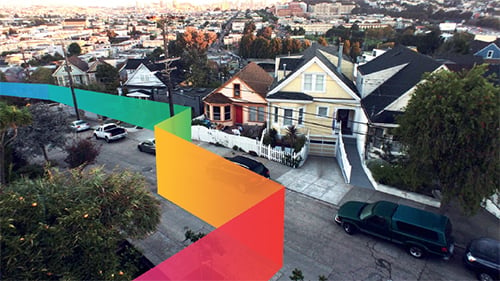
Evolution and Revolution: The Many Paths to DOCSIS® 4.0
Solution Brief
Learn about the many evolutionary and revolutionary options for transforming your HFC network.
The 7 most important cable technologies for 2021
Infographic
With bandwidth demand at an all-time high, now is the time to get familiar with new solutions that can increase network capacity and keep subscribers connected. Learn what technologies you should have on your radar this year.

The 7 most important cable technologies for 2021
Infographic
With bandwidth demand at an all-time high, now is the time to get familiar with new solutions that can increase network capacity and keep subscribers connected. Learn what technologies you should have on your radar this year.

The 7 most important cable technologies for 2021
Infographic
With bandwidth demand at an all-time high, now is the time to get familiar with new solutions that can increase network capacity and keep subscribers connected. Learn what technologies you should have on your radar this year.


A side-by-side comparison of centralized vs distributed access architectures
White Paper
This paper defines and compares two Classes of Access Architectures that will emerge this decade for Cable Networking.
Unlocking the Potential of Remote MACPHY
White Paper
Download this white paper and explore how a new approach to distributed access architecture (DAA) evolution can help unlock your network’s full potential.

Additional resources
-
Download
Looming Challenges and Potential Solutions for Future Distributed CCAP Architecture Systems
This paper focuses on the analysis of three sub-classes of Distributed CCAP Architectures (DCAs). The authors describe these DCAs, compare them by operational costs, ease-of-use, infrastructure compatibility, and design simplicity. Readers will gain a deeper understanding of the advantages and disadvantages for each approach.
-
Download
Network Migration Strategies for the Era of DAA, DOCSIS® 3.1 and Full Duplex DOCSIS®
As network evolution continues at a tremendous rate, MSOs are finding that selecting the right path is no easy task. This paper examines what is driving MSOs to provide multi-gigabit per second service, the technology enablers that will help them deliver those services, and the guiding factors that will help them navigate alternative migration paths. MSOs will need to have a complete toolkit of technology and procedures to aid in network migration and meet their goals and objectives.
-
Download
Data Sheet: Product Flyer - Distributed Access Architecture Services Suite
This data sheet describes the services available from CommScope Professional Services to help implement a DAA architecture.
-
Download
Cable's Fiber Outlook Survey Report
-
Download
Managing Distributed Access Devices with SDN: Centralized Operations for FIB Management
This paper focuses on how Software Defined Networking (SDN) can be used as part of a remote CCAP architecture to both provision and manage remote devices. It also demonstrates how centralized SDN controller coordination with today’s back office platforms can be used to orchestrate network resources enabling rapid service deployment throughout the network.
-
Download
A Comparison of Centralized and Distributed Access Architectures for PON
This paper will define and compare two classes of access architectures that will emerge this decade for Passive Optical Network (PON). It will propose the adoption of multiple wavelength technologies for 10G EPON DPoE systems and examine three types of CAA DPoE systems.
Services for Network Transformation
Your trusted partner for access network transformation, deployments, infrastructure management and engineering projects
-
Download
Looming Challenges and Potential Solutions for Future Distributed CCAP Architecture Systems
This paper focuses on the analysis of three sub-classes of Distributed CCAP Architectures (DCAs). The authors describe these DCAs, compare them by operational costs, ease-of-use, infrastructure compatibility, and design simplicity. Readers will gain a deeper understanding of the advantages and disadvantages for each approach.
-
Download
Network Migration Strategies for the Era of DAA, DOCSIS® 3.1 and Full Duplex DOCSIS®
As network evolution continues at a tremendous rate, MSOs are finding that selecting the right path is no easy task. This paper examines what is driving MSOs to provide multi-gigabit per second service, the technology enablers that will help them deliver those services, and the guiding factors that will help them navigate alternative migration paths. MSOs will need to have a complete toolkit of technology and procedures to aid in network migration and meet their goals and objectives.
-
Download
Data Sheet: Product Flyer - Distributed Access Architecture Services Suite
This data sheet describes the services available from CommScope Professional Services to help implement a DAA architecture.
-
Download
Cable's Fiber Outlook Survey Report
-
Download
Managing Distributed Access Devices with SDN: Centralized Operations for FIB Management
This paper focuses on how Software Defined Networking (SDN) can be used as part of a remote CCAP architecture to both provision and manage remote devices. It also demonstrates how centralized SDN controller coordination with today’s back office platforms can be used to orchestrate network resources enabling rapid service deployment throughout the network.
-
Download
A Comparison of Centralized and Distributed Access Architectures for PON
This paper will define and compare two classes of access architectures that will emerge this decade for Passive Optical Network (PON). It will propose the adoption of multiple wavelength technologies for 10G EPON DPoE systems and examine three types of CAA DPoE systems.
Services for Network Transformation
Your trusted partner for access network transformation, deployments, infrastructure management and engineering projects
